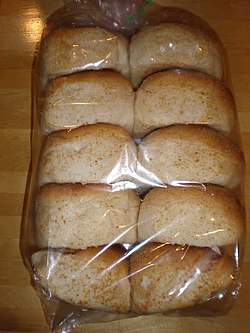Pandesal

Pan de sal plastic-wrapped for the grocer's.
|
|
| Type | Bread |
|---|---|
| Course | Breakfast |
| Place of origin | Philippines |
| Main ingredients | Flour, eggs, yeast, sugar, salt |
| |
|
Pandesal (corrupted from the Spanish pan de sal, meaning "bread of salt") is a common bread roll in the Philippines made of flour, eggs, yeast, sugar, and salt.
Pandesal is a popular yeast-raised bread in the Philippines. Individual loaves are shaped by rolling the dough into long logs (bastón) which are rolled in fine bread crumbs. These are then portioned, allowed to rise, and baked.
Its taste and texture closely resemble those of the Puerto Rican bread pan de agua and Mexican bolillos. Contrary to its name, pandesal tastes slightly sweet rather than salty.
Pandesal, or "pan-de-sal", was invented in the 16th-century Spanish Era in the Philippines and is Portuguese in origin. It is made of flour, yeast, sugar and salt. Usually it is soft, airy, chewy and has a slightly crunchy crust outside. It is commonly referred to as “the poor man’s bread” because it became the cheaper alternative to rice during the Philippine Revolution. In present day Philippines, you can find varieties of pan de sal such as raisin pan de sal, whole wheat pan de sal, cheese pan de sal, and vegetable pan de sal.
It is available at almost any bakery in the Philippines. Filipinos eat it in different ways but is most commonly consumed by dipping in hot coffee. It can also be integrated into many recipes, most common of which includes pan de sal pizza and the American peanut butter and jelly sandwich. It is usually complemented with strawberry jam, peanut butter, margarine or butter sprinkled with sugar, condensed milk, melted chocolate or even ice cream. It is usually served hot, but even when cold, pan de sal is still considered a favorite snack.
The pan de sal has become a staple breakfast in Philippine culture since the Hispanic era and is still considered the bread of the masses.
The "putok" is a variation on the pan de sal made from monay dough
...
Wikipedia
